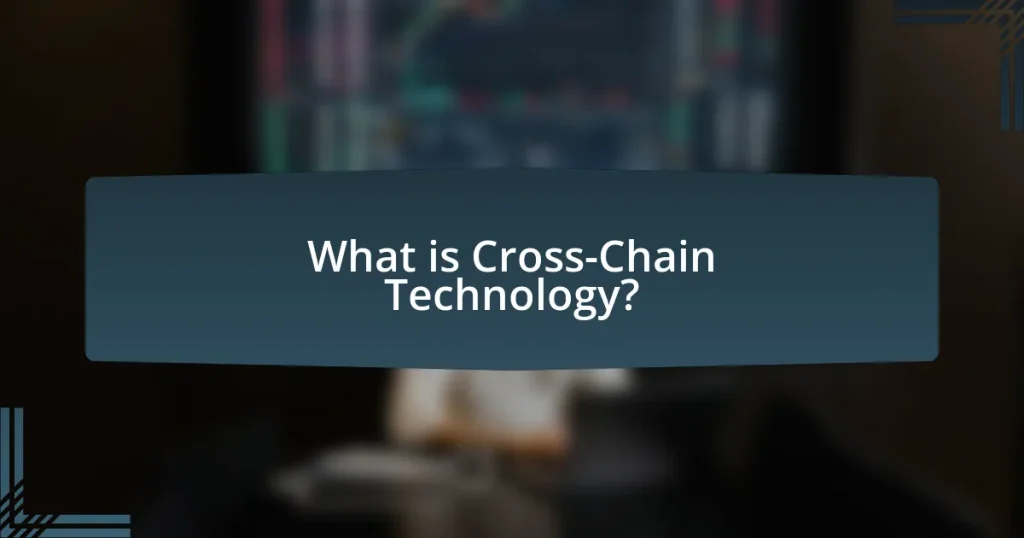Cross-Chain Technology is a crucial advancement in the blockchain ecosystem, enabling different blockchain networks to communicate and interact seamlessly. This article explores the mechanisms that facilitate interoperability, such as atomic swaps, cross-chain bridges, and interoperability protocols, highlighting their importance in enhancing user experience and liquidity in decentralized finance (DeFi) and non-fungible tokens (NFTs). It also addresses the challenges and limitations of Cross-Chain Technology, including security risks and scalability issues, while providing insights into best practices for implementation and development. Overall, the article emphasizes the significance of Cross-Chain Technology in creating a more interconnected and efficient blockchain landscape.

What is Cross-Chain Technology?
Cross-Chain Technology refers to the capability of different blockchain networks to communicate and interact with one another. This technology enables the transfer of assets and data across disparate blockchains, enhancing interoperability and allowing for more complex decentralized applications. For instance, projects like Polkadot and Cosmos utilize cross-chain technology to facilitate seamless interactions between various blockchain ecosystems, thereby increasing the overall utility and efficiency of blockchain networks.
How does Cross-Chain Technology facilitate interoperability?
Cross-Chain Technology facilitates interoperability by enabling different blockchain networks to communicate and exchange data seamlessly. This technology utilizes protocols and mechanisms, such as atomic swaps and cross-chain bridges, which allow assets and information to move across distinct blockchains without the need for intermediaries. For instance, the use of decentralized exchanges that support multiple blockchain assets exemplifies how Cross-Chain Technology enhances liquidity and user experience by allowing transactions between different cryptocurrencies. This interoperability is crucial for creating a more connected and efficient blockchain ecosystem, as evidenced by projects like Polkadot and Cosmos, which are specifically designed to enable cross-chain interactions.
What are the key components of Cross-Chain Technology?
The key components of Cross-Chain Technology include interoperability protocols, atomic swaps, and decentralized oracles. Interoperability protocols facilitate communication and data exchange between different blockchain networks, enabling seamless transactions. Atomic swaps allow for the direct exchange of assets across different blockchains without the need for intermediaries, ensuring trustless transactions. Decentralized oracles provide real-world data to smart contracts on various blockchains, enhancing their functionality and enabling cross-chain applications. These components collectively enhance the ability of different blockchain systems to work together, promoting a more interconnected blockchain ecosystem.
How do different blockchain networks interact through Cross-Chain Technology?
Different blockchain networks interact through Cross-Chain Technology by enabling the transfer of data and assets between distinct blockchain ecosystems. This interaction is facilitated by protocols and mechanisms such as atomic swaps, sidechains, and interoperability platforms like Polkadot and Cosmos, which allow for seamless communication and transaction execution across various blockchains. For instance, atomic swaps enable users to exchange cryptocurrencies from different blockchains without the need for a centralized exchange, ensuring security and decentralization. Additionally, interoperability platforms provide a framework for multiple blockchains to connect and share information, enhancing the overall functionality and utility of decentralized applications.
Why is Cross-Chain Technology important for the blockchain ecosystem?
Cross-Chain Technology is important for the blockchain ecosystem because it enables interoperability between different blockchain networks, allowing them to communicate and share data seamlessly. This capability enhances the overall functionality and utility of blockchain applications, as it facilitates the transfer of assets and information across diverse platforms. For instance, according to a report by the World Economic Forum, interoperability can significantly increase the efficiency of decentralized finance (DeFi) applications by allowing users to leverage multiple blockchains for various services, thereby expanding market access and liquidity.
What challenges does Cross-Chain Technology address?
Cross-Chain Technology addresses the challenges of interoperability between different blockchain networks. It enables seamless communication and data transfer across diverse blockchain ecosystems, which traditionally operate in isolation. This technology mitigates issues such as liquidity fragmentation, where assets are locked within a single blockchain, and enhances user experience by allowing access to a broader range of decentralized applications and services. Additionally, it resolves the challenge of scalability by enabling transactions to be processed across multiple chains, thereby reducing congestion on any single network.
How does Cross-Chain Technology enhance user experience?
Cross-Chain Technology enhances user experience by enabling seamless interaction between different blockchain networks. This interoperability allows users to transfer assets and data across various platforms without the need for intermediaries, reducing transaction times and costs. For instance, users can execute transactions on one blockchain while utilizing services or assets from another, thereby increasing efficiency and flexibility. According to a report by the World Economic Forum, cross-chain solutions can significantly improve liquidity and accessibility in decentralized finance, further validating the positive impact on user experience.

What are the different types of Cross-Chain Solutions?
The different types of cross-chain solutions include atomic swaps, cross-chain bridges, and interoperability protocols. Atomic swaps allow users to exchange cryptocurrencies from different blockchains without intermediaries, enhancing security and reducing reliance on centralized exchanges. Cross-chain bridges facilitate the transfer of assets between blockchains, enabling users to move tokens seamlessly across different networks. Interoperability protocols, such as Polkadot and Cosmos, create a framework for multiple blockchains to communicate and share data, promoting a more interconnected blockchain ecosystem. These solutions are essential for achieving interoperability in the blockchain space, as they address the challenges of fragmentation and enhance the usability of decentralized applications across various platforms.
How do atomic swaps function in Cross-Chain transactions?
Atomic swaps enable the direct exchange of cryptocurrencies across different blockchains without the need for intermediaries. They function through a process called Hash Time-Locked Contracts (HTLCs), which ensures that both parties fulfill their obligations within a specified time frame. If one party fails to complete the transaction, the funds are returned to the original owner, thus preventing loss. This mechanism relies on cryptographic hashes to lock the funds, ensuring that only the intended recipient can access them once the swap conditions are met. The effectiveness of atomic swaps is evidenced by their implementation in various blockchain projects, demonstrating their role in enhancing interoperability between different cryptocurrencies.
What are the advantages of using atomic swaps?
Atomic swaps offer several advantages, including enhanced security, reduced reliance on intermediaries, and increased liquidity across different blockchain networks. By enabling direct peer-to-peer exchanges of cryptocurrencies without the need for a centralized exchange, atomic swaps minimize the risk of hacks and fraud associated with third-party platforms. Additionally, they facilitate seamless transactions between different cryptocurrencies, promoting interoperability and expanding market access for users. This technology allows users to maintain control over their funds throughout the transaction process, further reinforcing security and trust in the exchange mechanism.
What limitations do atomic swaps have?
Atomic swaps have several limitations, including the requirement for both cryptocurrencies to support the same hashing algorithm and the complexity of the process, which can lead to user errors. Additionally, atomic swaps are generally limited to on-chain transactions, meaning they cannot be used for off-chain assets or tokens. The need for both parties to be online during the swap can also hinder the process, as it requires coordination and timing. Furthermore, the liquidity of the assets involved can affect the feasibility of the swap, as low liquidity may result in unfavorable exchange rates or difficulty in finding a counterparty.
What role do Cross-Chain Bridges play?
Cross-Chain Bridges facilitate the transfer of assets and data between different blockchain networks, enabling interoperability. By allowing users to move tokens and information seamlessly across diverse platforms, Cross-Chain Bridges enhance liquidity and expand the utility of digital assets. For instance, the Ethereum-Polygon Bridge enables users to transfer assets between Ethereum and Polygon, demonstrating how these bridges can connect ecosystems and improve user experience.
How do Cross-Chain Bridges operate?
Cross-chain bridges operate by enabling the transfer of assets and data between different blockchain networks. They achieve this through mechanisms such as locking assets on one chain and minting equivalent assets on another, allowing users to move their tokens seamlessly across ecosystems. For instance, when a user wants to transfer tokens from Ethereum to Binance Smart Chain, the bridge locks the tokens on Ethereum and creates a corresponding amount of wrapped tokens on Binance Smart Chain. This process ensures that the total supply remains constant across both chains, maintaining the integrity of the assets involved.
What security measures are necessary for Cross-Chain Bridges?
Security measures necessary for Cross-Chain Bridges include robust cryptographic protocols, multi-signature wallets, and regular security audits. Cryptographic protocols ensure secure communication between different blockchain networks, preventing unauthorized access and data breaches. Multi-signature wallets require multiple private keys to authorize transactions, adding an extra layer of security against theft. Regular security audits help identify vulnerabilities and ensure compliance with best practices, as evidenced by incidents where lack of audits led to significant breaches in various cross-chain platforms.

What are the potential use cases for Cross-Chain Technology?
Cross-Chain Technology has several potential use cases, primarily focused on enhancing interoperability between different blockchain networks. One significant use case is asset transfer, allowing users to move cryptocurrencies and tokens seamlessly across various blockchains, which can increase liquidity and market efficiency. Another use case is decentralized finance (DeFi) applications, where cross-chain capabilities enable users to access a broader range of financial services and products across multiple platforms, enhancing user experience and investment opportunities. Additionally, cross-chain technology can facilitate data sharing and communication between different blockchain ecosystems, which is crucial for enterprise solutions and supply chain management, improving transparency and traceability. Furthermore, it supports the development of cross-chain decentralized applications (dApps), which can leverage the strengths of multiple blockchains, thus providing users with more robust and versatile functionalities.
How can Cross-Chain Technology benefit decentralized finance (DeFi)?
Cross-Chain Technology can significantly benefit decentralized finance (DeFi) by enabling interoperability between different blockchain networks. This interoperability allows assets and data to be transferred seamlessly across various platforms, enhancing liquidity and expanding the range of financial services available to users. For instance, users can leverage the strengths of multiple blockchains, such as lower transaction fees or faster processing times, thereby optimizing their DeFi experience. Additionally, cross-chain solutions can facilitate the creation of more complex financial products, such as multi-chain lending and borrowing protocols, which can attract a broader user base and increase overall market efficiency.
What specific applications in DeFi utilize Cross-Chain Technology?
Specific applications in DeFi that utilize Cross-Chain Technology include decentralized exchanges like Thorchain and SushiSwap, lending platforms such as Aave and Compound, and cross-chain bridges like Ren and AnySwap. These applications enable users to trade, lend, and transfer assets across different blockchain networks, enhancing liquidity and accessibility. For instance, Thorchain allows users to swap assets across various chains without relying on centralized exchanges, while Ren facilitates the transfer of Bitcoin to Ethereum, demonstrating the practical use of cross-chain technology in DeFi ecosystems.
How does Cross-Chain Technology improve liquidity in DeFi?
Cross-Chain Technology improves liquidity in DeFi by enabling assets to move seamlessly between different blockchain networks. This interoperability allows users to access a broader range of financial services and trading opportunities, thereby increasing the overall liquidity available in decentralized finance markets. For instance, platforms like Polkadot and Cosmos facilitate cross-chain transactions, allowing users to trade assets from various blockchains without the need for centralized exchanges. This capability not only enhances market efficiency but also attracts more participants, further boosting liquidity across the DeFi ecosystem.
What impact does Cross-Chain Technology have on NFTs?
Cross-Chain Technology significantly enhances the functionality and marketability of NFTs by enabling interoperability across different blockchain networks. This technology allows NFTs to be transferred, traded, and utilized across various platforms, increasing their liquidity and accessibility. For instance, NFTs originally minted on Ethereum can be seamlessly moved to other blockchains like Binance Smart Chain or Solana, broadening their audience and potential use cases. This interoperability fosters a more vibrant ecosystem, as it encourages collaboration between different blockchain communities and applications, ultimately driving innovation and adoption in the NFT space.
How does Cross-Chain Technology enable NFT interoperability?
Cross-Chain Technology enables NFT interoperability by allowing different blockchain networks to communicate and share data seamlessly. This technology utilizes protocols and bridges that facilitate the transfer of NFTs across various blockchains, ensuring that assets can be accessed and utilized regardless of the underlying network. For instance, projects like Polkadot and Cosmos implement cross-chain mechanisms that enable NFTs created on one blockchain to be recognized and traded on another, enhancing their usability and market reach.
What are the benefits of Cross-Chain NFTs for creators and collectors?
Cross-Chain NFTs provide significant benefits for creators and collectors by enhancing accessibility and market reach. For creators, these NFTs allow for the distribution of digital assets across multiple blockchain platforms, increasing visibility and potential sales. Collectors benefit from the ability to acquire and trade NFTs across different ecosystems, which fosters a more diverse and liquid marketplace. This interoperability can lead to higher valuations and a broader audience, as evidenced by the growing number of platforms supporting cross-chain functionality, such as Ethereum and Binance Smart Chain collaborations.

What are the challenges and limitations of Cross-Chain Technology?
Cross-Chain Technology faces several challenges and limitations, primarily including interoperability issues, security vulnerabilities, and scalability concerns. Interoperability challenges arise from the diverse protocols and standards used by different blockchains, making seamless communication difficult. Security vulnerabilities can occur during cross-chain transactions, as they may expose networks to attacks such as double-spending or hacking. Scalability concerns stem from the increased complexity of managing multiple chains, which can lead to slower transaction speeds and higher costs. These challenges hinder the widespread adoption and efficiency of Cross-Chain Technology in facilitating interoperability among various blockchain networks.
What security risks are associated with Cross-Chain transactions?
Cross-Chain transactions are associated with several security risks, including smart contract vulnerabilities, reliance on third-party bridges, and potential for double-spending. Smart contracts can contain bugs or exploits that attackers may leverage, leading to unauthorized access or loss of funds. Additionally, many Cross-Chain transactions depend on third-party bridges, which can be points of failure or targets for attacks, as seen in incidents like the Poly Network hack in 2021 where over $600 million was stolen due to a vulnerability in the bridge. Lastly, the risk of double-spending arises when assets are transferred across chains, as the mechanisms to ensure the integrity of transactions may not be foolproof, potentially allowing malicious actors to exploit the system.
How can these security risks be mitigated?
Security risks in cross-chain technology can be mitigated through the implementation of robust cryptographic protocols and multi-signature wallets. These measures enhance transaction security by ensuring that only authorized parties can initiate or approve transactions, thereby reducing the likelihood of unauthorized access or fraud. Additionally, regular security audits and the use of decentralized oracles can help identify vulnerabilities and ensure accurate data transfer between chains, further strengthening the overall security framework.
What are the implications of smart contract vulnerabilities in Cross-Chain Technology?
Smart contract vulnerabilities in Cross-Chain Technology can lead to significant security risks, including the potential for financial loss and compromised data integrity. These vulnerabilities may allow malicious actors to exploit weaknesses in the smart contracts that facilitate transactions between different blockchain networks, resulting in unauthorized access or manipulation of assets. For instance, the 2021 Poly Network hack, which exploited a vulnerability in cross-chain transactions, resulted in the theft of over $600 million worth of cryptocurrencies, highlighting the critical need for robust security measures in smart contracts. Therefore, addressing these vulnerabilities is essential to ensure the reliability and safety of cross-chain interactions, which are vital for achieving true interoperability among blockchain systems.
What scalability issues does Cross-Chain Technology face?
Cross-Chain Technology faces significant scalability issues primarily due to the limitations in transaction throughput and latency across different blockchain networks. These limitations arise from the varying consensus mechanisms and protocols used by individual blockchains, which can lead to bottlenecks when attempting to facilitate cross-chain transactions. For instance, if one blockchain operates on a proof-of-work mechanism with slower transaction times, it can hinder the overall speed and efficiency of cross-chain operations. Additionally, the complexity of maintaining security and data integrity during these transactions can further exacerbate scalability challenges, as ensuring that all participating chains are synchronized and secure requires substantial computational resources.
How do different consensus mechanisms affect scalability?
Different consensus mechanisms significantly impact scalability by determining how transactions are validated and added to the blockchain. For instance, Proof of Work (PoW) requires substantial computational power and time to validate transactions, which can limit the number of transactions processed per second, thus hindering scalability. In contrast, Proof of Stake (PoS) allows validators to create new blocks based on the number of coins they hold, enabling faster transaction validation and higher throughput. Additionally, mechanisms like Delegated Proof of Stake (DPoS) further enhance scalability by allowing a limited number of delegates to validate transactions, increasing efficiency. Research indicates that PoS can achieve transaction speeds exceeding 1,000 transactions per second, while PoW networks like Bitcoin typically process around 7 transactions per second. Therefore, the choice of consensus mechanism directly influences a blockchain’s ability to scale effectively.
What solutions are being developed to enhance scalability in Cross-Chain systems?
Solutions being developed to enhance scalability in Cross-Chain systems include the implementation of Layer 2 solutions, such as state channels and sidechains, which allow transactions to occur off the main blockchain, reducing congestion. Additionally, protocols like Polkadot and Cosmos utilize a hub-and-spoke model that enables multiple blockchains to communicate and share resources efficiently, thereby increasing overall throughput. Research indicates that these approaches can significantly improve transaction speeds and reduce costs, as evidenced by Polkadot’s ability to process thousands of transactions per second through its parachain architecture.

How can one effectively implement Cross-Chain Technology?
To effectively implement Cross-Chain Technology, one should utilize interoperability protocols that facilitate communication between different blockchain networks. These protocols, such as Polkadot and Cosmos, enable the transfer of assets and data across chains, ensuring seamless interaction. Additionally, employing atomic swaps can enhance security and efficiency by allowing direct peer-to-peer exchanges without intermediaries. Research indicates that the adoption of these technologies can significantly reduce transaction costs and increase the speed of cross-chain operations, as evidenced by the growing number of decentralized applications leveraging such solutions.
What best practices should be followed when using Cross-Chain Technology?
When using Cross-Chain Technology, best practices include ensuring robust security measures, implementing standardized protocols, and maintaining clear communication between chains. Security is paramount; utilizing multi-signature wallets and regular audits can mitigate risks associated with cross-chain transactions. Standardized protocols, such as the Inter-Blockchain Communication (IBC) protocol, facilitate seamless interactions and reduce compatibility issues. Additionally, clear communication between chains enhances transparency and user trust, as evidenced by successful implementations in projects like Polkadot and Cosmos, which prioritize interoperability and security in their designs.
How can developers ensure security in Cross-Chain applications?
Developers can ensure security in Cross-Chain applications by implementing robust cryptographic protocols and utilizing secure communication channels. These measures protect data integrity and confidentiality during cross-chain transactions. For instance, employing multi-signature wallets and decentralized oracles can mitigate risks associated with unauthorized access and data manipulation. Additionally, conducting thorough audits and employing formal verification methods can identify vulnerabilities in smart contracts, thereby enhancing overall security. Research indicates that vulnerabilities in cross-chain bridges have led to significant financial losses, emphasizing the need for stringent security practices in this domain.
What tools and platforms are recommended for Cross-Chain development?
Recommended tools and platforms for Cross-Chain development include Polkadot, Cosmos, and Chainlink. Polkadot enables interoperability between different blockchains through its unique relay chain architecture, allowing for seamless communication and data transfer. Cosmos utilizes the Inter-Blockchain Communication (IBC) protocol to facilitate interactions among various independent blockchains, promoting scalability and flexibility. Chainlink provides decentralized oracles that connect smart contracts with real-world data across multiple blockchains, enhancing functionality and interoperability. These platforms are widely recognized in the blockchain community for their effectiveness in enabling cross-chain interactions.
What are common troubleshooting tips for Cross-Chain Technology?
Common troubleshooting tips for Cross-Chain Technology include verifying network compatibility, ensuring correct transaction formats, and checking for smart contract errors. Verifying network compatibility involves confirming that the chains involved support the same protocols and standards, which is crucial for successful interactions. Ensuring correct transaction formats requires users to adhere to the specific requirements of each blockchain, as discrepancies can lead to failed transactions. Checking for smart contract errors is essential, as bugs or misconfigurations in the contracts can prevent successful cross-chain operations. These steps are vital for maintaining effective interoperability between different blockchain networks.
How can users resolve transaction failures in Cross-Chain systems?
Users can resolve transaction failures in Cross-Chain systems by verifying transaction details, checking network status, and utilizing retry mechanisms. Verifying transaction details ensures that the correct addresses and amounts are used, which can prevent errors. Checking the network status helps users identify if any issues are affecting the cross-chain communication, such as congestion or downtime. Utilizing retry mechanisms allows users to automatically attempt the transaction again after a failure, which can be effective if the failure was due to temporary network issues. These steps are essential for maintaining successful transactions in cross-chain environments.
What resources are available for learning more about Cross-Chain Technology?
Comprehensive resources for learning about Cross-Chain Technology include academic papers, online courses, and industry reports. Notable academic papers such as “Cross-Chain Technology: A Survey” provide foundational knowledge and insights into the mechanisms and protocols involved. Online platforms like Coursera and Udemy offer courses specifically focused on blockchain interoperability, including cross-chain solutions. Additionally, industry reports from organizations like the Blockchain Research Institute detail current trends and future directions in cross-chain technology, making them valuable for understanding its practical applications and implications.










